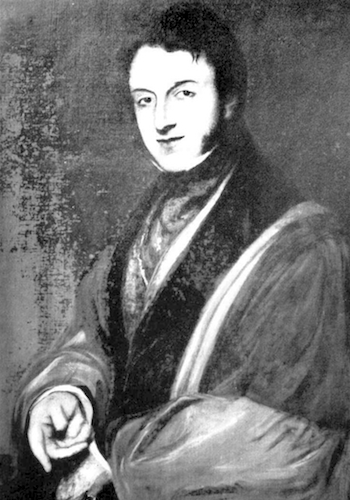Richard Clarke Sewell is best known as the man who inaugurated Australia's first university law course at Melbourne Law School, and as the nation's first law lecturer. But poor health – and the demon drink – cut short a fascinating career.

Richard Clarke Sewell, the University of Melbourne's first reader in law, was not only Australia's first university law lecturer – he also received the first law degree awarded by an Australian university: a doctorate of laws conferred by the University of Melbourne on 17 April 1857. Sewell was entitled to the degree automatically, thanks to his Oxford doctorate.
What did our first lecturer look like? No photograph seems to have survived in Australia, but a portrait of him has turned up in a book about his notable family, privately printed in England in 1906. Showing Sewell in his Oxford DCL robes, the painting is probably by Irish artist Thomas Clement Thompson, who exhibited a portrait of him at the Royal Academy in London in 1842.
Mountague Charles Owen, the genealogist who recorded the lives of the Sewells, described Richard as "the handsomest of a handsome family". Whether or not that was true, he was certainly "a versatile and rapid writer," accumulating a string of scholarly publications on law, history and church governance.
But Owen also gave a clue to possible future trouble, when he said that Sewell "had in him many of the qualities of a Bohemian." His emigration to Australia in his early 50s was puzzling. He was apparently well established as an author, barrister and fellow of Magdalen College, Oxford – not someone who seemed to need a new start in gold-rush Victoria. Perhaps he was escaping his family's financial troubles, but later information suggests that there may have been something else he was hoping to leave behind.
In 1862, the worldly-wise diarist Annie Baxter Dawbin consulted Sewell for legal advice. She found him in his room at the London Tavern in Elizabeth Street. "He is far gone I think in the drinking line," she wrote. "He looks a complete sot!" When he died two years later, a post-mortem found cirrhosis of the liver. He had probably been a heavy drinker for years.
It was a sad end for someone Owen depicts as something of a golden boy. Sewell's once-prominent practice at the Melbourne bar had dwindled with his declining health, and his wife Eliza died in 1861 after only three years of marriage. They had no children.
His brief time as law lecturer was unhappy, too. Ill-health and the demands of practice led him to cancel many classes, and he resigned after only five months, apparently unmissed by his students or the University.
Yet there's something to be said for our unlucky founding lecturer. At the inauguration of the law course, Sewell rose to the occasion in a polished address that linked scholarly Oxford tradition with practical training for the profession.
He believed in the significance of what he was doing. That significance is confirmed by the Melbourne Law School's historical role in pioneering university study in a profession once learnt solely through apprenticeship. By 1872, Victoria had become one of the first places in the common law world to make university training compulsory for all new lawyers.
Now that we have a likeness of Sewell, there are other gaps in our pictorial record that we'd love to fill. We know Edward Jenks only through later photographs that show him much older than he was when he became the Melbourne Law School's combative second Dean at the age of 28. Maybe there's another portrait waiting to be found.
Image: Richard Clarke Sewell DCL, from Owen, The Sewells of the Isle of Wight
Source: Harold B. Lee Library, Brigham Young University